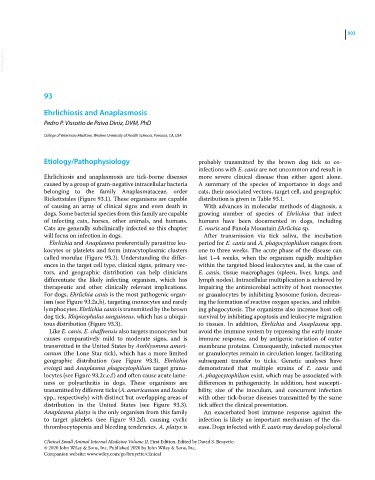Page 965 - Clinical Small Animal Internal Medicine
P. 965
903
VetBooks.ir
93
Ehrlichiosis and Anaplasmosis
Pedro P. Vissotto de Paiva Diniz, DVM, PhD
College of Veterinary Medicine, Western University of Health Sciences, Pomona, CA, USA
Etiology/Pathophysiology probably transmitted by the brown dog tick so co‐
infections with E. canis are not uncommon and result in
Ehrlichiosis and anaplasmosis are tick‐borne diseases more severe clinical disease than either agent alone.
caused by a group of gram‐negative intracellular bacteria A summary of the species of importance in dogs and
belonging to the family Anaplasmataceae, order cats, their associated vectors, target cell, and geographic
Rickettsiales (Figure 93.1). These organisms are capable distribution is given in Table 93.1.
of causing an array of clinical signs and even death in With advances in molecular methods of diagnosis, a
dogs. Some bacterial species from this family are capable growing number of species of Ehrlichia that infect
of infecting cats, horses, other animals, and humans. humans have been documented in dogs, including
Cats are generally subclinically infected so this chapter E. muris and Panola Mountain Ehrlichia sp.
will focus on infection in dogs. After transmission via tick saliva, the incubation
Ehrlichia and Anaplasma preferentially parasitize leu- period for E. canis and A. phagocytophilum ranges from
kocytes or platelets and form intracytoplasmic clusters one to three weeks. The acute phase of the disease can
called morulae (Figure 93.2). Understanding the differ- last 1–4 weeks, when the organism rapidly multiplies
ences in the target cell type, clinical signs, primary vec- within the targeted blood leukocytes and, in the case of
tors, and geographic distribution can help clinicians E. canis, tissue macrophages (spleen, liver, lungs, and
differentiate the likely infecting organism, which has lymph nodes). Intracellular multiplication is achieved by
therapeutic and other clinically relevant implications. impairing the antimicrobial activity of host monocytes
For dogs, Ehrlichia canis is the most pathogenic organ- or granulocytes by inhibiting lysosome fusion, decreas-
ism (see Figure 93.2a,b), targeting monocytes and rarely ing the formation of reactive oxygen species, and inhibit-
lymphocytes. Ehrlichia canis is transmitted by the brown ing phagocytosis. The organisms also increase host cell
dog tick, Rhipicephalus sanguineus, which has a ubiqui- survival by inhibiting apoptosis and leukocyte migration
tous distribution (Figure 93.3). to tissues. In addition, Ehrlichia and Anaplasma spp.
Like E. canis, E. chaffeensis also targets monocytes but avoid the immune system by repressing the early innate
causes comparatively mild to moderate signs, and is immune response, and by antigenic variation of outer
transmitted in the United States by Amblyomma ameri- membrane proteins. Consequently, infected monocytes
canum (the Lone Star tick), which has a more limited or granulocytes remain in circulation longer, facilitating
geographic distribution (see Figure 93.3). Ehrlichia subsequent transfer to ticks. Genetic analyses have
ewingii and Anaplasma phagocytophilum target granu- demonstrated that multiple strains of E. canis and
locytes (see Figure 93.2c,e,f) and often cause acute lame- A. phagocytophilum exist, which may be associated with
ness or polyarthritis in dogs. These organisms are differences in pathogenicity. In addition, host suscepti-
transmitted by different ticks (A. americanum and Ixodes bility, size of the inoculum, and concurrent infection
spp., respectively) with distinct but overlapping areas of with other tick‐borne diseases transmitted by the same
distribution in the United States (see Figure 93.3). tick affect the clinical presentation.
Anaplasma platys is the only organism from this family An exacerbated host immune response against the
to target platelets (see Figure 93.2d), causing cyclic infection is likely an important mechanism of the dis-
thrombocytopenia and bleeding tendencies. A. platys is ease. Dogs infected with E. canis may develop polyclonal
Clinical Small Animal Internal Medicine Volume II, First Edition. Edited by David S. Bruyette.
© 2020 John Wiley & Sons, Inc. Published 2020 by John Wiley & Sons, Inc.
Companion website: www.wiley.com/go/bruyette/clinical

